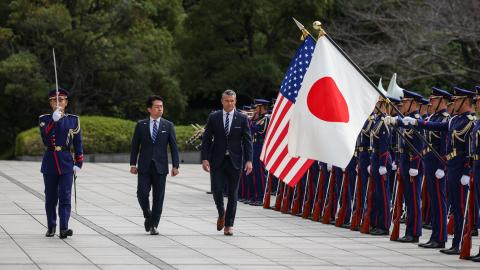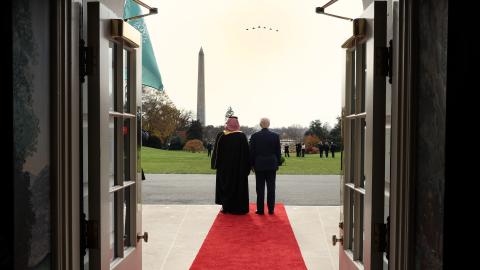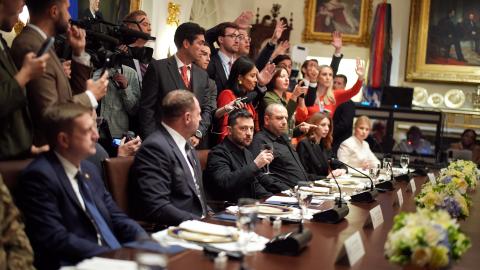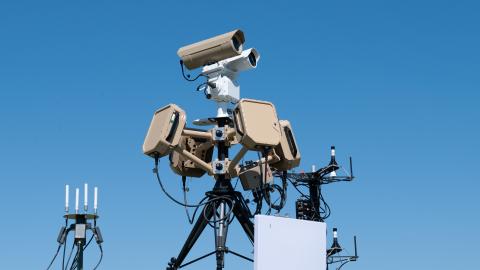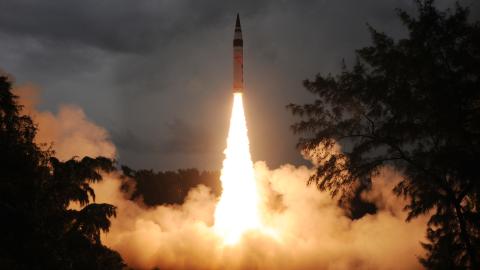Which religious traditions have most impacted nuclear policy? In light of the ongoing conflict in Ukraine, the Christian faiths of Russia and America, the two original nuclear superpowers, might come to mind. Neither apocalyptic Evangelicals in the US nor the Kremlin-friendly Russian Orthodox Church have been shy in voicing their opinions on nukes. Another obvious contender might be theocratic Iran, where the Ayatollahs are purportedly just weeks away from acquiring the material needed for a bomb, believed by many to represent a victory for Islam. But historical research into the question of religious influence on nuclear arms yields another rather unexpected answer: the Hindu tradition has one of the strongest cases to make for influencing the history of nuclear decision-making.
Hindu-inflected political worldviews animated India’s approach to nuclear weapons in two highly consequential periods. In the decades following China’s successful nuclear tests in 1964, the legacy of Gandhian non-violence was instrumental in keeping India from fully arming when doing so was a clear strategic necessity. Yet in 1998, when the geopolitical costs of arming had risen above the benefits in most strategists’ estimations, India’s newly-elected Hindu nationalist government launched nuclear weapons tests—inspired in no small part by parallel Hindu religious perspectives that stood in opposition to those that restrained India from building nuclear weapons decades before.
To be sure, these worldviews weren’t the only or even the primary consideration in India’s decisions on nuclear armament: China’s nuclear capabilities, Pakistan’s nuclear prospects, and American opposition to proliferation all established the strategic context within which India operated. But as the country’s leaders weighed their options within these constraints, Hindu political theologies profoundly shaped their calculus—overriding conventional assumptions about national security and power projection.
Both decisions complicate the realist theories that aim to explain the dynamics of nuclear proliferation and represent cautionary tales of the power of ideas to shape nuclear policy in unexpected ways. As humanity returns to a world of greater nuclear uncertainty, the surprising lessons offered by Hindu politics’ tryst with nuclear armament are more important than ever.
Satyagraha & Nuclear Aversion
Rewind about 60 years ago, and New Delhi had every incentive to take up nuclear arms: Two years after India lost a brief yet consequential border war to China, Beijing successfully fired off its own nuclear missiles—an ominous sign given the two countries’ continued territorial disputes. India’s strategic community demanded nuclear capabilities to rebalance their new, glaring vulnerability—an imbalance so severe that even then-US Secretary of State Dean Rusk privately conceded that it should compel India to arm.
India’s scientific establishment, meanwhile, had come to possess the material and know-how to develop a nuclear bomb and was pushing political authorities aggressively towards that end. A 1971 public opinion poll further revealed that 63% of Indians supported armament, yet nuclear proliferation was still postponed. The only partial exception was a single, half-hearted “peaceful nuclear explosion” detonated in 1974, which both underscored India’s capability to develop full nuclear arms and its resolve to not fully weaponize. Why?
The answer has much to do with Gandhi’s nonviolent legacy. Inspired by the moral vision of Hindu renunciants, Gandhi’s religio-political doctrine of satyagraha, or “truth force,” dictated that resisting the bomb—or even suffering a blast with nonviolent resolve—would eventually win over aggressors to the truth of nonviolence. In the short two-and-a-half years that Gandhi was alive to see the nuclear age, he exhibited an unflappable faith that the spiritual victory of resisting the allure of the bomb would ultimately mark a triumph for India and humanity—regardless of the risks of remaining unarmed, or the suffering that a nuclear blast could inflict.
In contrast to many of Gandhi’s more unusual political ideas, his stridently idealistic aversion to nuclear arms would have a surprisingly strong influence on India’s nuclear policy—if serendipitously. Gandhi’s successor and India’s first Prime Minister, Jawaharlal Nehru, staked India’s claim to influence nuclear affairs to the country’s role as a voluntarily-unarmed moral compass for the world, deliberately drawing on Gandhi’s moral authority. The tactic was successful, earning goodwill and a powerful international platform for New Delhi for several years. But it also limited India: as its strategic calculus evolved after China’s acquisition and indications of Pakistani ambitions for the same, India could not acquire arms without undermining the basis of its international influence on the matter.
For soft power credibility if not for conviction, several of Nehru’s successors—including Indira and Rajiv Gandhi—maintained this pattern of nuclear restraint to varying degrees. However, at the most crucial juncture in India’s history of nuclear restraint—immediately following China’s successful nuclear test after the humiliating Sino-Indian War—Gandhian principles proved decisive. In the face of intense pressure from the opposition, his own party, and India’s nuclear establishment—and lacking a viable strategy to address China’s massive new strategic advantage—then-Prime Minister Lal Bahadur Shashtri took an impassioned, public stance to uphold Gandhi’s ideals. His unpopular, politically risky plea blunted the considerable momentum towards armament, declaring to India’s parliament that “India does represent to some extent the desire to save humanity from wars and annihilation. We cannot give up this stand.” Nor was he the only national leader for whom Gandhi’s legacy had direct impact: this principled restraint was echoed years later when Morarji Desai, though governing during a less strategically critical moment, used his first press conference as prime minister to emphasize his own unyielding Gandhian convictions on the matter, asserting that “Even if the whole world arms itself with the bombs, we will not do so.”
The Hindu Bomb
Now fast forward to 1998 when, in a stunning reversal of a half-century of Gandhian nuclear abstention, India shocked the world with a series of nuclear tests that seemed to defy explanation. For one, India’s relationship with China was more stable than it had been in years—active nuclear threats from Beijing were off the table. India also enjoyed significant conventional military advantage over Pakistan. Adding nukes to the equation would only invite Pakistan to do the same—which, of course, it did—diminishing India’s strategic edge and exposing it to needless existential risk. India’s relationship with the US was also at a relative high, and testing could only jeopardize that increasingly important rapport. For all these reasons, most of India’s major political parties, public intellectuals, and even military officials opposed the tests in the late 1990s—again begging the question: Why?
Here, again, the answer stems in large part from the thought of a Hindu religio-political figure, in this case the ascetic-turned-organizer M. S. Golwalkar. Throughout the mid-20th century, Golwalkar was arguably the most influential leader of Hindu nationalism, a movement dedicated to reviving Hindu cultural and political authority across India. As the longest-serving head of the Rashtriya Swayamsevak Sangh (RSS), Golwalkar led the organization from the margins to a large, influential force in Indian society at the center of the Hindu nationalist cause. He also oversaw the creation of a number of powerful affiliated spin-off entities resonant with his and the RSS’s viewpoint. This included the creation of a Hindu nationalist political party, the Bharatiya Jana Sangh (BJS), which was the first to call for a nuclear India and forerunner of the currently governing Bharatiya Janata Party (BJP), the party to ultimately achieve nuclear weapons for India.
For Golwalkar, a former monk of Vivekananda’s renowned Ramakrishna Mission, realizing a nuclear India was a religious injunction. In a telling exposition of the Hindu epic the Bhagavad Gita, Golwalkar preached that it was the cosmic duty of the Hindus to take up nuclear arms with faith in the “ultimate triumph” of their spiritual strength over “demoniac forces of evil” in the world. Not unlike Gandhi, Golwalkar believed that immaterial moral forces shape history and would work with the Hindus so long as they fulfilled their duty. But contra Gandhi, Golwalkar saw that duty as a mandate to acquire material power commensurate with the Hindus’] spiritual might: as he put it, “the world worships only the strong.” Only through a union of spiritual and material power could India fulfill its sacred mission for humanity—a nuclear vision that Golwalkar would help enshrine as one of the leading political ambitions of the Hindu nationalist movement through the range of organizations he led, founded, and influenced until his death in 1973.
Golwalkar’s behind-the-scenes organizing efforts were slow to bear fruit. But by the time the BJP formed its first stable government in 1998, the party had spent decades advocating for nuclear arms. Within weeks, the newly-elected Prime Minister Atal Bihari Vajpayee, a Golwalkar acolyte, ordered India’s inaugural nuclear weapons test—a hasty decision made not so much out of geopolitical necessity as a fulfillment of one of the core aspirations of the Hindu nationalist movement.
In an echo of Golwalkar’s thought, the tests were christened “Operation Shakti,” a religiously-charged Sanskrit term for cosmic power, which Vajpayee proclaimed was the “greatest meaning” of tests, rather than strategic interests. Shortly after the tests, the Universal Hindu Council, a powerful pan-Hindu religious organization founded by Golwalkar in 1966, campaigned to erect a temple to the Hindu goddess of power above the detonation site—a fitting tribute to Golwalkar’s vision.
Realism & Idealism in Nuclear Decisions
To be clear, it was never religious inspiration alone that drove Gandhi’s successors to avoid arming, nor Vajpayee’s administration to launch. Far from it: a host of other factors—international prestige, material and diplomatic costs, and bureaucratic structures to name a few—played large roles in the complex decisions that led up to 1998. Nonetheless, India’s divergent paths on nuclear weapons in the 20th century drew their intellectual foundations from two decidedly religious Hindu political philosophers, both of whom proposed spiritual realities as essential elements of their respective nuclear rationales.
This is remarkable insofar as nuclear deterrence, as understood by most American theorists, assumes that the grave, existential risks posed by nuclear weapons should compel nations toward hard-nosed, unsentimental realism. Both Gandhi and Golwalkar’s legacies defy that strategic orthodoxy: Gandhi’s by averting armament even in the face of clear nuclear threats, and Golwalkar’s by advocating for nuclear weapons when their strategic benefits were least apparent.
With Iran, China, Russia, and North Korea all posing renewed nuclear threats, India’s perplexing nuclear decisions should give the world pause. Gandhi and Golwalkar’s shared belief that transcendent moral forces in history would tilt circumstances in their favor is hardly unique to either of their traditions of Hindu thought. Unabashed idealism, embodied by Gandhi and Golwalker, has already triumphed over the pragmatic realism that was expected to determine nuclear decisions on the international stage—twice. It may well do so again.
